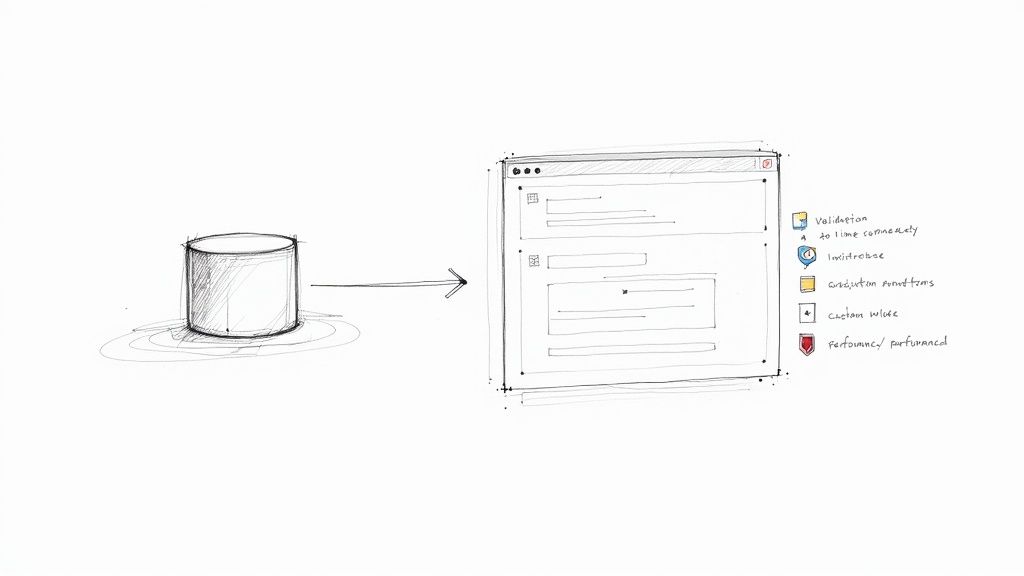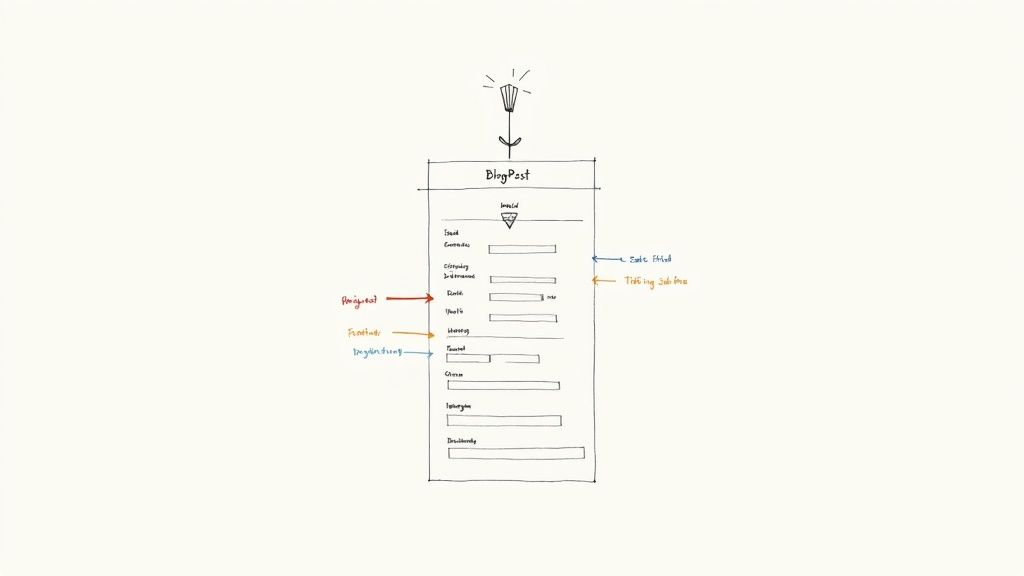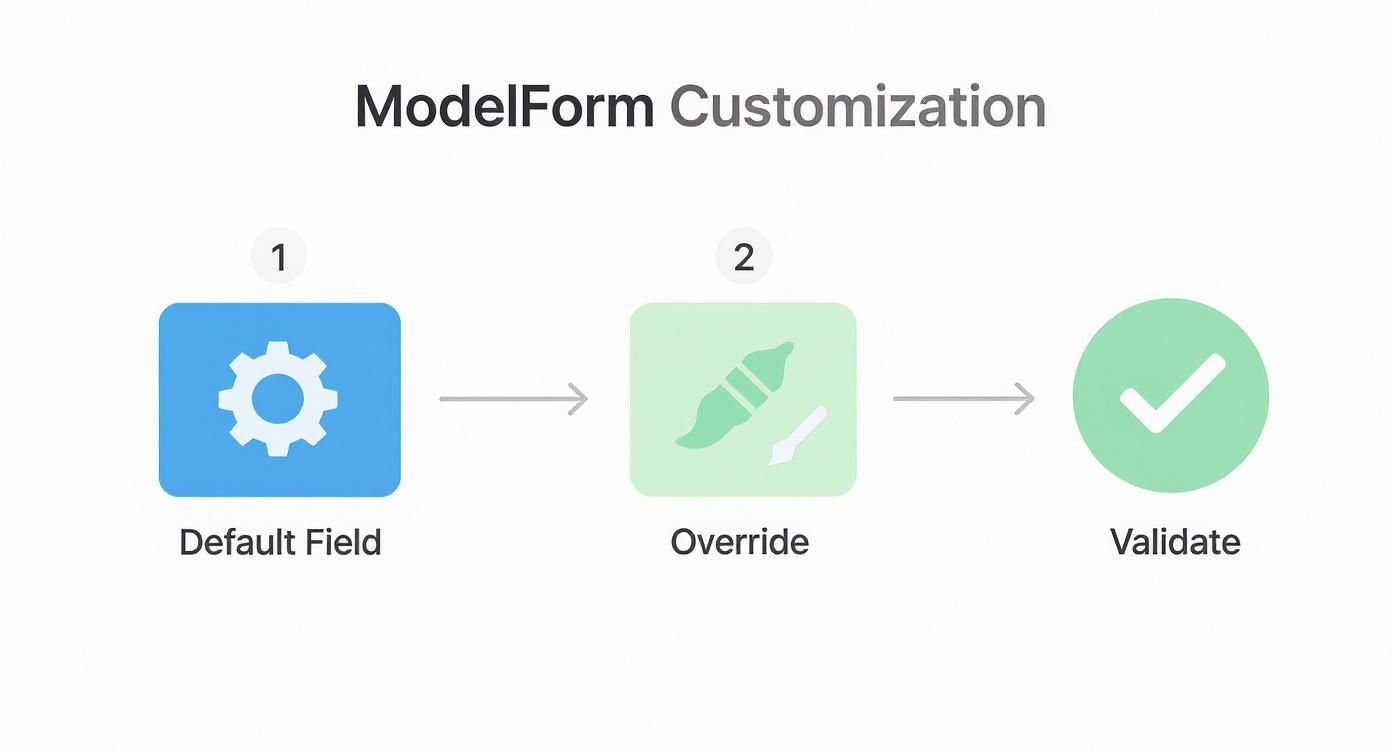A Guide to Humane Django Model Forms

Django ModelForms are a lifesaver. They are a brilliant shortcut for creating forms straight from your Django models, automatically handling fields, basic validation, and saving data. It's a core feature that truly embodies the framework's "Don't Repeat Yourself" philosophy.
Why Manual Forms Are a Recipe for Burnout
Let's be real: writing HTML forms by hand can be a soul crushing task. First, you carefully define all your fields in models.py. Then, you jump over to forms.py and define almost the exact same fields all over again. Finally, you wire it all up in the view, crossing your fingers that you did not misspell a field name somewhere along the way.
I once lost an entire afternoon debugging a form, going crazy over a ValidationError, only to find a single, infuriating typo between my model field and my form field. It was a classic violation of the "Don't Repeat Yourself" (DRY) principle, and the bug was entirely my fault for creating that redundancy in the first place.

That feeling when you have written the same field name in three different files.
The Bridge Between Your Data and Your Users
This is the exact problem Django ModelForms were built to solve. They act as a smart, intuitive bridge between your database models and the user facing forms on your site. Instead of forcing you to duplicate your model's structure, a ModelForm simply inspects your model and generates the right form fields for you.
This magical connection brings a few huge advantages to the table:
- Speed: You can spin up complex data entry forms in just a few lines of code.
- Consistency: The form's validation rules automatically mirror your model's constraints (
max_length,blank=False, etc.), which drastically cuts down on data integrity issues. - Maintainability: When you update a field in your model, the form updates right along with it. No more hunting down changes across multiple files.
Let's do a quick side by side to really drive the point home.
Manual Forms vs Django Model Forms
This table shows why ModelForms are such a game changer for developer productivity and code quality.
| Aspect | Manual Django Form | Django ModelForm |
|---|---|---|
| Field Definition | Fields must be manually defined in forms.py, duplicating the model. |
Fields are automatically generated from the model. |
| Validation | Basic validation (max_length, required) must be redefined. |
Inherits validation rules directly from model field definitions. |
| Data Saving | Requires custom logic in the view to save form data to the model instance. | Provides a simple .save() method to handle object creation and updates. |
| Maintainability | High. Changes to the model require manual updates in the form file. | Low. The form automatically reflects changes made to the model. |
The difference is night and day. ModelForms let you focus on the unique parts of your application instead of getting bogged down in repetitive boilerplate code.
Since Django's early days, this focus on pragmatic, rapid development has been a core principle. The official Django Developers Survey in 2021 found that around 75% of developers were using versions 3.2 or higher, where ModelForm functionality is a deeply integrated and essential part of the workflow.
It's not just about saving a few keystrokes; it's about building a more logical, robust, and maintainable application from the ground up.
Right, enough theory. The real "aha!" moment with Django ModelForms comes when you build one yourself and see it spring to life. Let's get our hands dirty and create our very first ModelForm for a simple BlogPost model. This is not just a code dump; we're going to walk through this together.

First things first, we need a model to work with. Let's imagine we have a BlogPost model sitting in our models.py file that looks something like this:
# blog/models.py
from django.db import models
from django.contrib.auth.models import User
class BlogPost(models.Model):
title = models.CharField(max_length=200)
content = models.TextField()
author = models.ForeignKey(User, on_delete=models.CASCADE)
published_date = models.DateTimeField(blank=True, null=True)
def __str__(self):
return self.title
It's pretty straightforward stuff: a title, content, author, and a publication date. Our goal is to spin up a form that lets users create and edit these posts, all without manually defining every single field.
Creating the Form Class
Now for the magic. We'll pop open a forms.py file in our app directory (create one if it does not exist) and define our ModelForm.
The process boils down to just two steps:
- Importing
ModelFormfromdjango.forms. - Creating a new class that inherits from it, using an inner
Metaclass to link it to our model.
Here's what that looks like in code:
# blog/forms.py
from django import forms
from .models import BlogPost
class BlogPostForm(forms.ModelForm):
class Meta:
model = BlogPost
fields = ['title', 'content', 'published_date']
That's it. Seriously. By setting model = BlogPost and listing the fields we want, Django now knows everything it needs to build the form. It peeks at the BlogPost model and automatically generates the right form fields—a CharField for the title, a TextField (which renders as a <textarea>) for the content, and a DateTimeField for the date.
You might notice we left out the author field. That's intentional. We'll typically set the author in the view based on the currently logged in user, so there's no reason to expose it in the form itself.
Wiring It Up in the View
With our form class ready, let's put it to work in a simple view for creating a new blog post. Inside views.py, we'll handle both GET requests (which display an empty form) and POST requests (which process the submitted data).
# blog/views.py
from django.shortcuts import render, redirect
from .forms import BlogPostForm
def create_blog_post(request):
if request.method == 'POST':
form = BlogPostForm(request.POST)
if form.is_valid():
# Don't save to the database yet
post = form.save(commit=False)
post.author = request.user # Set the author here
post.save() # Now we can save the instance
return redirect('blog_post_list')
else:
form = BlogPostForm()
return render(request, 'create_post.html', {'form': form})
The form.save() method is the real star of the show here. It handles creating a new BlogPost instance and saving it to the database with all the cleaned data from the form.
The commit=False argument is a crucial pattern you will use all the time. It creates the model instance in memory without actually hitting the database. This gives us a chance to add or modify data—like setting our author—before the final save. This one method replaces a ton of manual data handling code, making our view incredibly clean and much easier to read.
Customizing Fields and Adding Validation
The default ModelForm is a fantastic start, but the real world is messy. Sooner or later, every application needs a few tweaks. What if you need to add a specific CSS class to an input for styling, or maybe change a plain text field into a proper password input? This is where we roll up our sleeves and take control.
This is the moment where you go from just using Django ModelForms to truly mastering them. We'll get into overriding default behaviors, customizing how fields are rendered, and most importantly, enforcing your own business logic through validation.
Tweaking Field Widgets and Labels
Let's say in our BlogPostForm, we want the content textarea to be a bit larger and have a specific CSS class for our frontend framework. Easy. We can do this using the widgets attribute right inside our form's Meta class.
# blog/forms.py
from django import forms
from .models import BlogPost
class BlogPostForm(forms.ModelForm):
class Meta:
model = BlogPost
fields = ['title', 'content', 'published_date']
widgets = {
'content': forms.Textarea(attrs={'rows': 10, 'class': 'special-textarea'}),
'published_date': forms.DateInput(attrs={'type': 'date'}),
}
With just a few lines, we've told Django to render the content field with a <textarea> that has 10 rows and a special-textarea class. We also switched the published_date input to use the browser's native date picker, which is a nice little UX win. This fine grained control is incredibly powerful for shaping the final HTML without ever leaving Python.
Enforcing Rules with Custom Validation
Now for the really interesting part: custom validation. Django's automatic checks based on your model fields are great, but what about rules that are specific to your application's logic? For instance, what if we want to ensure a blog post's publish_date is never set to a date in the past?
We can hook into Django's validation process by adding a special method to our form class called clean_<fieldname>().
# blog/forms.py with custom validation
import datetime
from django import forms
from .models import BlogPost
class BlogPostForm(forms.ModelForm):
# ... (Meta class as before) ...
def clean_published_date(self):
date = self.cleaned_data.get('published_date')
if date and date < datetime.date.today():
raise forms.ValidationError("You cannot set a publication date in the past!")
return date
By adding that clean_published_date method, Django will automatically run our check right after its default validation. If the date is in the past, it raises a ValidationError. This stops the form from being saved and sends a helpful error message back to the user. This kind of validation is absolutely essential for maintaining data integrity beyond simple database constraints.
Of course, sometimes your validation needs are more complex, especially when dealing with APIs. For those scenarios, you might need to validate raw JSON data directly. If you are building APIs, you can check out our guide on validating JSON request bodies in Django.
This level of control is a key reason why so many large scale applications are built on Django. Its mature form handling allows for incredibly rapid development, which can reduce form creation time by as much as 40% compared to coding them by hand. By keeping validation logic unified within the framework, ModelForms help build more secure and robust applications.
Managing Relationships With Inline Formsets
Things get really interesting when your models have relationships. Picture an invoice with multiple line items, or a blog post that can have several tags. Trying to manage these related objects on the same page using standard Django model forms can quickly become a tangled mess.
I once tried to build this logic by hand for a client project, and it involved so much manual state management and prefixing of form fields that the code was almost impossible to read. It was a nightmare to maintain.
This is exactly where inlineformset_factory steps in. It's one of Django's more advanced features, and frankly, it can feel a little intimidating at first. But once you get the hang of it, it's a lifesaver for building complex user interfaces. It lets you create a dynamic group of forms for a related model, all managed under a single parent object.
Let's build a complete example to demystify this. Imagine we have a Project model and a related Task model, where one project can have many tasks.
Setting Up the Formset
First, we use inlineformset_factory in our views.py to create a "factory." This factory's job is to generate sets of forms for our Task model, all tied to a specific Project instance.
# views.py
from django.forms import inlineformset_factory
from .models import Project, Task
def manage_project_tasks(request, project_id):
project = Project.objects.get(pk=project_id)
TaskFormSet = inlineformset_factory(Project, Task, fields=('title', 'completed'), extra=1)
if request.method == 'POST':
formset = TaskFormSet(request.POST, instance=project)
if formset.is_valid():
formset.save()
# Redirect to a success page
else:
formset = TaskFormSet(instance=project)
return render(request, 'manage_tasks.html', {'formset': formset})
The extra=1 parameter is key here; it tells the formset to always display one extra blank form, making it easy for users to add a new task. The instance=project argument is what links the entire set of task forms to our specific project.
The visualization below outlines a common process flow for working with Django's form system, from using defaults to overriding and validating.

This flow shows how inline formsets build upon the core principles of customization and validation, applying them to multiple related forms at once.
Rendering and Processing the Forms
In the template, we need to iterate over the formset to render each individual task form. There's one crucial piece you cannot forget: the management form, {{ formset.management_form }}. This is a hidden set of fields Django uses to track the total number of forms, initial forms, and which ones (if any) have been marked for deletion.
<!-- manage_tasks.html -->
<form method="post">
{% csrf_token %}
{{ formset.management_form }}
{% for form in formset %}
<div class="task-form">
{{ form.as_p }}
</div>
{% endfor %}
<button type="submit">Save Tasks</button>
</form>
When the user submits the form, our view logic takes over. The formset.is_valid() call validates all the forms at once. If everything checks out, formset.save() handles creating new tasks, updating existing ones, and even deleting tasks marked for deletion. It's an incredibly powerful abstraction.
The elegance of inlineformset_factory is a testament to how well Django's ORM handles complex relationships. For a deeper exploration of a similar concept, you might be interested in mastering the many to many relationship in Django, which builds on these ideas.
Statistical trends highlight the importance of model forms within the wider web development ecosystem. The 2025 PyCharm survey shows that Django remains tightly coupled with PostgreSQL databases (used by 76% of developers), and model forms are the primary way to abstract these database interactions. This allows for automated form creation that maps directly to database schemas. With 44% of developers upgrading Django at every stable release, features like formsets see continuous improvement. You can discover more insights from The State of Django 2025 survey to see how these tools are evolving.
Common Pitfalls And Lessons Learned
I have spent more hours than I'd like to admit staring at my screen, debugging some really weird behavior in Django ModelForms. The road to getting comfortable with them is paved with a few classic gotchas. Think of this section as my attempt to share that hard won wisdom so you can sidestep the same headaches.
One of the most common traps is what I call the "accidental duplicate" bug. You build an edit view, pass your form to the template, and everything looks perfect. But when you hit save, it creates a brand new object instead of updating the one you were editing.
I once burned a solid hour on this before realizing my mistake. I had completely forgotten to pass the object instance to the form in my view.
The lesson is simple but absolutely critical: When you are editing an existing object, always instantiate your form withinstance=my_object. Without it, theModelFormhas no idea it's supposed to be updating something, so it just defaults to creating a new entry.
The Commit False Pattern
Another rite of passage for any Django dev is getting a handle on the save(commit=False) pattern. This little argument is incredibly powerful, but it is just as easy to misuse. It tells the form to create a Python object from the validated data without actually touching the database yet.
This is a lifesaver when you need to add data that does not come from the user, like setting an author field to the currently logged in request.user.
The pitfall? Forgetting the final my_object.save() call after you've made your modifications. You end up with a perfectly valid form that does absolutely nothing, leaving you scratching your head wondering why your data is not showing up. This pattern is a great example of where a solid testing strategy can save you from yourself, something you can explore in our guide to test-driven development for saner coding.
Security And Performance Traps
Finally, let's talk security. It's incredibly tempting to use fields = '__all__' in your Meta class just for convenience. Please, do not do this in production code.
Imagine you add a sensitive field to your model later on, like an is_admin boolean. If you are using __all__, that field will be automatically exposed in your form, creating a potential mass assignment vulnerability.
Always use an explicit list of fields to act as a whitelist. This ensures only the fields you intend to be user editable are ever processed. It's a simple change that drastically improves your app's security posture and can save future you from an easily avoidable crisis.
A Few Common Questions
Even after you get the hang of ModelForms, a few questions tend to pop up time and time again. These are not just textbook problems; they're the real world snags and tricky spots we all hit when we start pushing ModelForms a little harder.
Let's walk through some of the most common ones.
How Do I Add A Field To A ModelForm That Is Not In The Model?
This is a classic. You need a "terms and conditions" checkbox, but that does not belong on your database model. Easy.
You can add extra fields to a ModelForm just like you would with a regular forms.Form. Just declare the field right on the form class, completely outside of the inner Meta class.
For instance, terms_accepted = forms.BooleanField(required=True). Django is smart enough to see that this field is not part of the model. It'll render it and validate it along with everything else, but it will not try to save it to the database. You'll just need to grab its value from form.cleaned_data in your view after validation and handle it yourself.
What Is The Difference Between Using fields and exclude?
Both fields and exclude live in the Meta class and control which model fields show up in your form. They just work from opposite ends.
fields = ['title', 'content']is an explicit whitelist. Only these fields will be included, and all others will be ignored.exclude = ['author', 'created_at']is a blacklist. All model fields except for these specific ones will be included.
As a rule of thumb, always preferfields. It's a much safer security practice. If you add a new, sensitive field to your model later (likeis_admin), usingexcludecould accidentally expose it in your form.fieldsforces you to be explicit about what a user can edit.
Can I Use A ModelForm Without Rendering It In A Template?
Absolutely, and you will find yourself doing this all the time, especially when building APIs with Django or Django Rest Framework. This is a seriously powerful pattern.
You can instantiate the form with data directly from a request, like data=request.POST or data=request.data for an API. Then, you just call form.is_valid().
If the data passes validation, form.save() handles all the database creation or updates for you. The form becomes a validation and data handling engine that never touches HTML. This keeps your view logic incredibly clean and lets you reuse the exact same validation rules for both your web frontend and your API endpoints.
Are you an early stage startup looking to accelerate your roadmap and build robust, scalable systems? As an expert in Kuldeep Pisda, I specialize in helping companies like yours deliver on their technical vision with deep execution and thoughtful architecture. Let's build something great together.
Subscribe to our newsletter.
Become a subscriber receive the latest updates in your inbox.







Member discussion